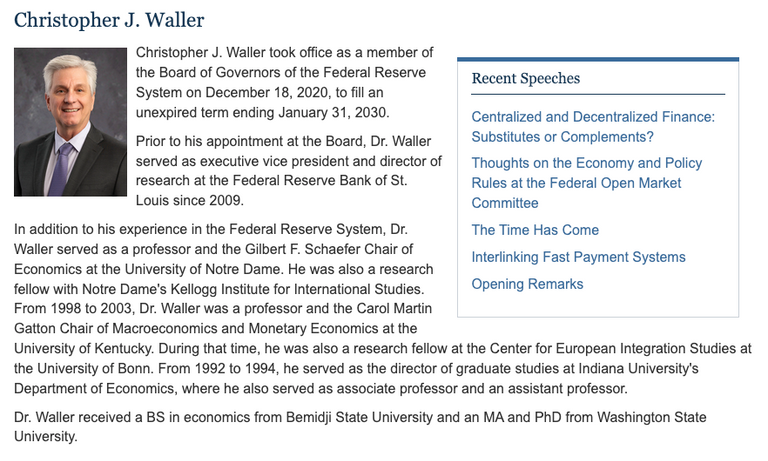In a recent speech at the Vienna Macroeconomics Workshop, Federal Reserve Governor Christopher J. Waller offered a nuanced perspective on the evolving landscape of finance. His insights provide valuable food for thought for investors navigating the intersection of traditional and emerging financial systems.
https://www.federalreserve.gov/newsevents/speech/waller20241018a.htm

Federal Reserve Governor Christopher J. Waller
The Roots of Centralized Finance
Waller began by reminding us why centralized finance emerged in the first place. It's easy to forget, but the middlemen we often criticize actually serve a crucial purpose:
- They reduce the time and cost of finding trading partners
- They provide expertise in assessing risks
- They offer legal and contractual frameworks
Think about trying to lend out your savings without a bank. You'd need to advertise, vet potential borrowers, draw up contracts, and bear all the risk yourself. It's no wonder banks have been around since ancient Mesopotamia!
The Promise of DeFi
Enter decentralized finance, or DeFi. These new technologies offer some compelling advantages:
- Reduced need for trust in intermediaries
- More direct control over assets
- Potential for faster, cheaper transactions
Waller highlighted key innovations like distributed ledger technology (DLT), tokenization, and smart contracts. These aren't just buzzwords – they're tools that could reshape how we trade and manage assets.
Complements, Not Substitutes
Here's where Waller's perspective gets really interesting. Instead of viewing DeFi as a replacement for traditional finance, he sees it as complementary. Why?
- DLT could improve recordkeeping for 24/7 trading
- Tokenization of traditional assets could speed up transfers
- Smart contracts could reduce settlement and counterparty risks
We're already seeing major financial institutions experiment with these technologies. It's not about tearing down the old system, but enhancing it.
Stablecoins: A Bridge Between Worlds
Waller gave special attention to stablecoins, seeing them as a potential bridge between DeFi and traditional finance. They offer:
- A "safe" asset for decentralized trading
- Potential for reduced payment costs globally
But he also cautioned about the risks, particularly the potential for runs. Proper regulation will be key to realizing their benefits.
The Reality Check
Despite the excitement around DeFi, Waller reminded us that complete decentralization is unlikely. Why?
- Intermediation still provides value for average users
- Crypto exchanges still require trusting a third party
- Regulatory challenges, especially around know-your-customer rules
What This Means for Investors
Don't Ignore DeFi: While it may not replace traditional finance, it's driving innovation that could reshape the entire financial landscape.
Watch for Hybrid Solutions: Companies that successfully bridge DeFi and traditional finance could be big winners.
Consider the Risks: New technologies bring new vulnerabilities. Regulatory responses will be crucial.
Think Long-Term: These changes won't happen overnight. Focus on the long-term potential rather than short-term hype.
Stay Informed: The pace of innovation is rapid. Keeping up with developments in both DeFi and traditional finance will be crucial.
The Bottom Line
Waller's speech paints a picture of evolution, not revolution. The future of finance likely lies in a hybrid system that combines the best of both worlds – the efficiency and innovation of DeFi with the tried-and-true structures of traditional finance.
For savvy investors, this presents a wealth of opportunities. But it also requires a nuanced understanding of both systems and the ability to spot where they might converge.
As we navigate this changing landscape, let's remember that finance, at its core, is about facilitating economic activity and improving lives. Whether centralized or decentralized, that should remain our North Star.